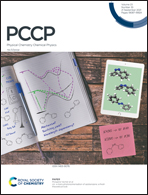Stereodynamic control of cold rotationally inelastic CO + HD collisions†
Abstract
Quantum control of molecular collision dynamics is an exciting emerging area of cold collisions. Co-expansion of collision partners in a supersonic molecular beam combined with precise control of their quantum states and alignment/orientation using Stark-induced Adiabatic Raman Passage allows exquisite stereodynamic control of the collision outcome. This approach has recently been demonstrated for rotational quenching of HD in collisions with H2, D2, and He and D2 by He. Here we illustrate this approach for HD(v = 0, j = 2) + CO(v = 0, j = 0) → HD(v′ = 0, j′) + CO(v′ = 0, j′) collisions through full-dimensional quantum scattering calculations at collision energies near 1 K. It is shown that the collision dynamics at energies between 0.01–1 K are controlled by an interplay of L = 1 and L = 2 partial wave resonances depending on the final rotational levels of the two molecules. Polarized cross sections resolved into magnetic sub-levels of the initial and final rotational quantum numbers of the two molecules also reveal a significant stereodynamic effect in the cold energy regime. Overall, the stereodynamic effect is controlled by both geometric and dynamical factors, with parity conservation playing an important role in modulating these contributions depending on the particular final state.

- This article is part of the themed collection: 2021 PCCP HOT Articles


 Please wait while we load your content...
Please wait while we load your content...
